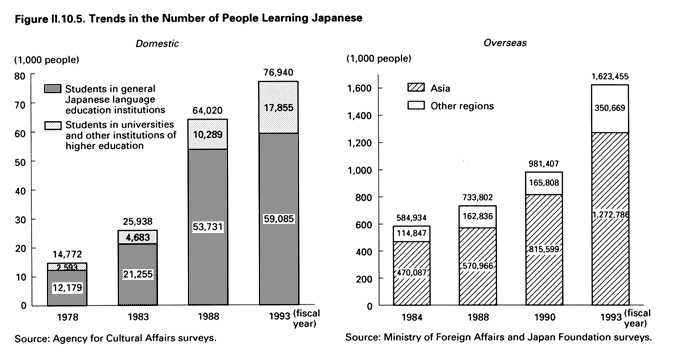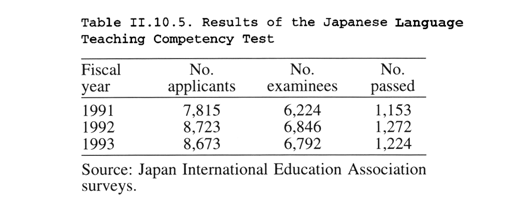| Home > Policy > White Paper, Notice, Announcement > White Paper > JAPANESE GOVERMENT POLICICIES IN EDUCATION, SCIENCE AND CULTURE 1994 > PART II Chapter 10 Section 5 2 | ||
According to a survey conducted by the Agency for Cultural Affairs, as of November 1993 training programs and courses for Japanese language teachers were being offered at the undergraduate level by 84 national, local public, and private universities, 16 graduate schools, and 11 junior colleges, and the total number of students enrolled was 15,421. In addition, 108 programs and courses were being offered at Japanese language teacher training institutions other than universities and junior colleges.
The Japan International Education Association administers the Japanese Language Teaching Competency Test to certify that applicants have acquired the level of knowledge and ability required to work as specialists in the field of Japanese language education ( Table II.10.5 )
The Centre for Teaching Japanese as a Foreign Language of the National Language Research Institute conducts long-term (10-month) advanced courses to improve the specialized knowledge of people who are already working as Japanese language teachers. It also operates the Mutual Training Network for Japanese Language Teachers (12 months).


Agencies involved in the field of Japanese language education are actively developing the following types of Japanese teaching methods and teaching materials.
Designation of pilot schools to cooperate in Japanese language education research
Commissioning of Japanese language education research, sponsoring of Japanese language education research conferences for Japanese language teachers, sponsoring of liaison conferences for leaders in Japanese language education organizations
Research and development relating to Japanese language teaching materials
Production and distribution of Japanese language teaching materials, administration of Japanese language education training courses for teachers, sponsoring of international symposiums on the Japanese language and Japanese language education
The Association for the Promotion of Japanese Language Education inspects and certifies Japanese language education facilities in accordance with the National Standards for the Operation of Japanese Language Institutes. The association has certified 551 facilities, but the number of facilities in existence at the end of March 1994 had fallen to 407, reflecting school closures and other factors. These facilities could accommodate approximately 67,000 students, but only about 33,000 students were actually enrolled. Since August 1994 applicants for certification have been required to have a stronger economic base.
The association is also working in other ways to improve the quality of Japanese language education facilities, including the preparation of Japanese Language Institutes in Japan, a directory of Japanese language education facilities that satisfy its criteria; the promotion of efficient student enrollment; and research and development pertaining to Japanese language teaching materials. The Ministry of Education, Science and Culture subsidizes these activities.
The Japanese Language Proficiency Test for foreign nationals is administered in Japan by the Japan International Education Association and overseas jointly by the Japan Foundation and the Japan International Education Association. The examination is divided into four levels, from Level 1 (about 900 hours of Japanese study) to Level 4 (about 150 hours of Japanese study). Japanese universities are notified of the scores of Level 1 examinees at the examinees' request. Universities use these scores in selecting privately financed foreign students for admission.
This test is extremely important to students of Japanese as a means of measuring their proficiency. Because of the increase in demand in recent years, studies are now being conducted regarding the timing and method of the test and the possibility of multiple examinations ( Table II.10.6 ).

The Foundation for the Welfare and Education of Asian People, commissioned by the Ministry of Education, Science and Culture, provides four-month intensive Japanese language courses for Indochinese refugees who wish to settle in Japan. It also supplies learning materials and Japanese teachers for Indochinese refugees who continue to study Japanese after settlement to assist them in developing the language skills they need to live in Japanese society.
The Agency for Cultural Affairs produces Japanese language learning materials and teacher's reference materials for returnees from extended stays in China. These materials are distributed free of charge to returnees and Japanese language teachers. The Agency also holds seminars and research conferences for teachers.
The rapid increase in the number of foreign residents in regional communities has prompted a number of measures. For example, in fiscal 1994 the Ministry of Education, Science and Culture began to designate model regions and hold training seminars for Japanese language teachers.
By the end of 1993 the number of foreign nationals living in Japan had risen to approximately 1.32 million. There has been a particularly large increase in the number of ethnic Japanese immigrants from South America since the enforcement of the amended Immigration Control and Refugee Recognition Act (amended in December 1989) in June 1990. This trend has led to an increase in the number of foreign children enrolled in schools. According to a survey conducted by the Ministry of Education, Science and Culture in September 1993, a total of 10,450 foreign children requiring Japanese language education were enrolled in public elementary and lower secondary schools.
Measures implemented by the Ministry of Education, Science and Culture in response to this situation include the preparation of teaching materials and teaching guides, the allocation of additional teachers to provide Japanese language instruction in schools that have admitted foreign children, the designation of pilot schools to cooperate in research and surveys concerning approaches to guidance and other aspects, and the establishment of traveling guidance programs.
The Ministry of Education, Science and Culture, in cooperation with the Ministry of Home Affairs and local governments, is implementing the Program for Regional and Educational Exchange for Mutual Understanding (the REX Program), whereby teachers in public lower and upper secondary schools in Japan are sent overseas to teach Japanese and introduce Japanese culture in secondary educational institutions for two-year periods. The aims of this program are to meet the growing demand for Japanese language education in other countries, to contribute to the internationalization of Japanese education, and to promote international exchange at the regional level ( Table II.10.7 ).

| Back to Top | MEXT HOME |